Both evergreen and deciduous trees change the color of their foliage in response to growth, season, temperature, disease, air pollution and soil conditions. Autumn is the most colorful time for most trees, as many different species exhibit their colorful fall foliage. Vivid shades of yellow, orange, red, rust and purple compete in a range of brilliant variations. Some trees also change the color of their foliage as the leaves unfurl and mature. The changing palette of leaf colors creates visual interest and contrast in to a home landscape.
Why do trees change color in fall?
In the fall, because of changes in the length of daylight and changes in temperature, the leaves stop their food-making process. The chlorophyll breaks down, the green color disappears, and the yellow to orange colors become visible and give the leaves part of their fall splendor.
At the same time other chemical changes may occur, which form additional colors through the development of red anthocyanin pigments. Some mixtures give rise to the reddish and purplish fall colors of trees such as dogwoods and sumacs, while others give the sugar maple its brilliant orange.
Yellow colour is the most common autumn foliage color of many trees. Others display mostly browns, red, pink, bright-orange etc. All these colors are due to the mixing of varying amounts of the chlorophyll residue and other pigments in the leaf during the fall season. Common trees with brilliant fall color include:
- Sugar Maple (Acer saccharum)
- Red Maple (Acer rubrum)
- Baldcypress (Taxodium distichum)
- Aspen (Populus ssp)
- Flowering Dogwood (Cornus florida)
- Sourwood (Oxydendrum arboreum)
- Sassafras (Sassafras albidum)
- Sweetgum (Liquidambar styraciflua)
- Japanese Maple (Acer palmatum)
- Sweet Birch (Betula lenta)
- Ginko (Ginko biloba)
- Black tupelo (Nyssa sylvatica)
- Scarlet oak (Quercus coccinea)
- Persian parrotia (Parrotia persica)
- Japanese stewartia (Stewartia pseudocamellia)
- Japanese snowbell tree (Styrax japonicus)
Flowering Dogwood
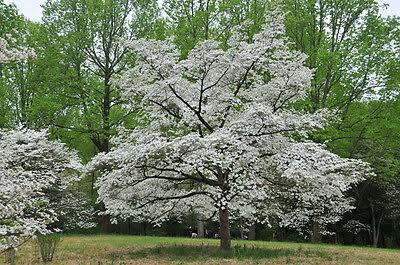
Flowering Dogwood tree is prized for its attractive spring blooms and growing habits.This attractive species features a short trunk, low, horizontally growing branches and a rounded or more upright canopy. Oval leaves grow opposite, and the bark of mature trees is broken into squares, giving it a checkered appearance. Flowering Dogwood tree can grow up to 20 feet in height in the first 25 years of growth. Under the right conditions, mature dogwoods can reach a height of 40 feet.
Flowering dogwoods have green leaves with pale undersides from spring through summer. The green is more yellow than blue giving the tree a warm appearance in the garden. In the fall, flowering dogwoods put on a show of color as the green leaves turn to reds and oranges. The underside of the leaf remains pale during this fall change and adds to the tree’s beauty as the leaves flutter in fall winds.
Sugar Maple

Sugar maple (Acer saccharum) grows 50 to 80 feet tall and up to 50 feet wide. It’s a slow grower, about 12 inches per year. In the fall, its palmate leaves put on a spectacular show, turning a range of colors from red to yellow to orange. It’s an excellent shade tree; its dense canopy supplies heavy shade to a yard. Sugar maples need lots of space and air circulation to grow, at least 35 to 50 feet between multiples trees.
Red Maple

Also called swamp maple, Carolina red maple and scarlet maple, red maple reaches about 40 to 60 feet in height and is somewhat oval to conical in shape. Its leaves have 3 to 5 lobes and are best known for their intense fall color display. Beginning early in the season, the leaves begin to turn yellow and red, then age to bright scarlet and crimson, heralding autumn with a dramatic visual display. It also has bright red buds in the spring. The buds open to show red flowers and, later, dangling red-winged fruit, called samaras, that are as attractive as the flowers. While red maples are more prominent in the eastern United States, they can be found in nearly every state and are common to deciduous forests and landscapes almost everywhere.
Also Read: Trees With Pink Flowers
Baldcypress
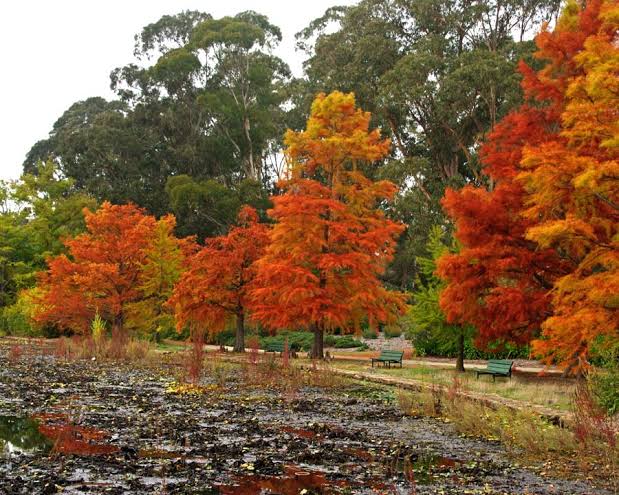
Bald cypress is a deciduous conifer that grows between 40 and 130 feet tall and can live for over 500 years. The tree grows in swampy areas, along the banks of creeks, rivers and streams that have slow-moving water. A bald cypress develops a tangle of roots termed “knees” above the ground that anchor the tree in saturated grounds, but the tree grows equally well, without knees, on higher terrain.Like other conifers, the bald cypress produces waxy needles instead of leaves. Its delicate, feathery foliage is sage green when new, turns to copper-gold in autumn and then falls with the first frosts, leaving the tree “bald.”
Aspen

Aspen trees reach up to 65 feet tall in ideal growing conditions. The uppermost branches are sometimes bent over horizontally. Twigs are dark brown, slender and shiny. Aspen tree bark is creamy white with dark brown or light gray markings. In the spring, tiny flowers cluster together forming silvery catkins, which appear before the leaves unfurl. Aspen trees add beauty to landscaping with their smooth white bark and striking foliage, which changes from dark green to golden in autumn.
Sourwood
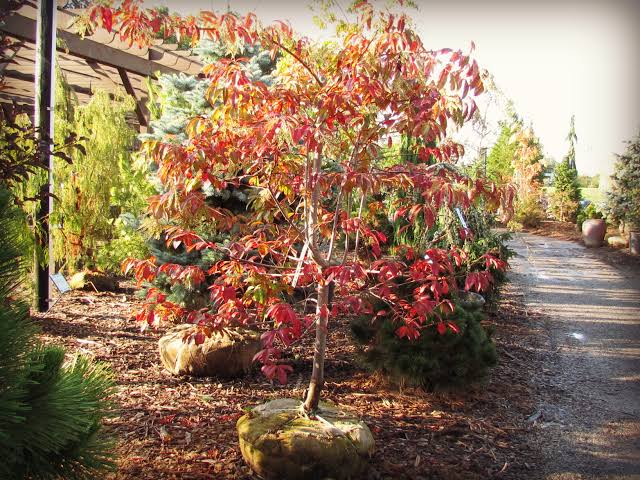
Sourwood grows slowly to its mature, 25- to 40-feet height and 12- to 20-feet spread. The slender-trunked tree has a narrow canopy of glossy, tapering deep green foliage. In early to midsummer, loose, curving sprays of tiny, white bell flowers droop from its branches. Silvery seed pods, an eye-catching complement to its crimson fall leaves, often remain on the tree through winter. Its major shortcomings are intolerance of pollution and drought and occasional susceptibility to leaf spot disease. Sourwood’s shallow root system resents competition from nearby grass or plants.
Sassafras
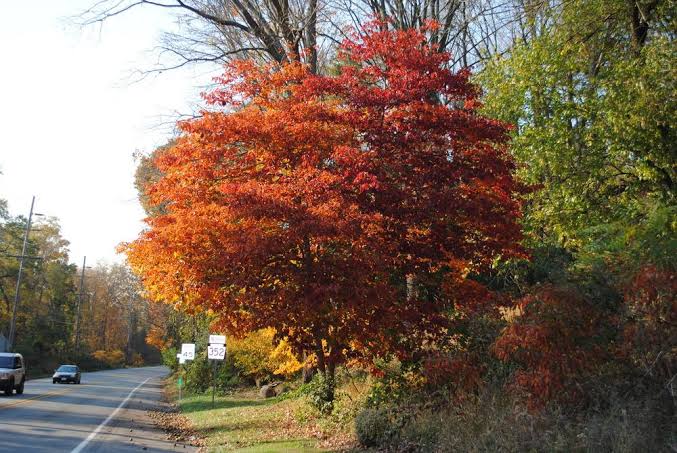
Sassafras is a perennial, deciduous tree that can grow to a mature height of up to 60 feet. Sassafras leaves are alternately arranged and often grow in three shapes: three-lobed, mitten-shaped and elliptical or egg-shaped. In summer, the 7-inch long, 4-inch wide leaves are bright green on top and white underneath, and then they turn a yellowish-orange and reddish-orange color in fall. When crushed, the leaves produce a fragrance similar to that of root beer. The plant also produces either male or female flowers in spring.
Sweet gum

A sweet gum is a deciduous tree in the witch hazel family that ranges in height from 60 to 100 feet and has a narrow oval canopy. Its growth rate is moderate to rapid, putting on height at a rate of 1 to 4 feet a year for the first five to 10 years and 12 to 15 inches per year thereafter. The foliage is palmate, like a maple leaf, but more deeply lobed and star shaped. It is glossy green in the spring and summer, turning to vivid red, yellow and even purple in the fall. Sweet gum is long-life tree, it can live more than 150 years and doesn’t flower or produce seed for the first 15 to 20 years of its growth.
Japanese Maple
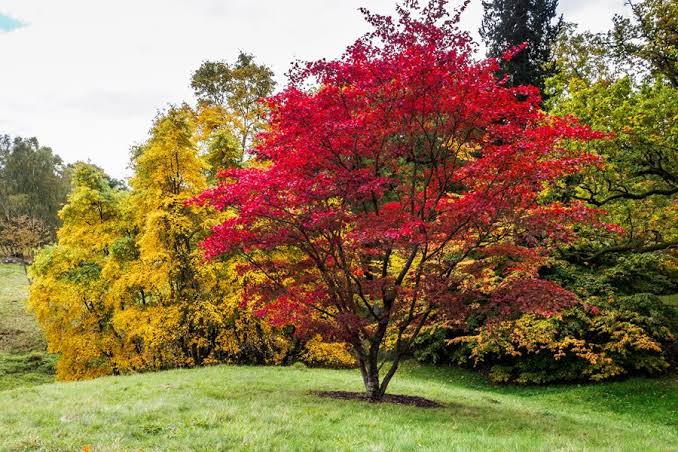
Japanese Maples are highly valued by landscapers and home gardeners for their compact size, ferny leaves and brilliant autumn foliage. The tree is characterized by a low growth habit, usually staying under 20 feet tall, and deeply dissected palmate leaves, which may be up to 5-inches long. The summer foliage may be green, golden or deep red and often turn yellow and orange in the fall. Japanese maples are understory trees, which means they grow in the dappled shade under taller trees; usually evergreens. Some cultivars tolerate full sun better than others. These trees prefer sites with fertile, moist, slightly acidic, well-drained soil.
Sweet Birch
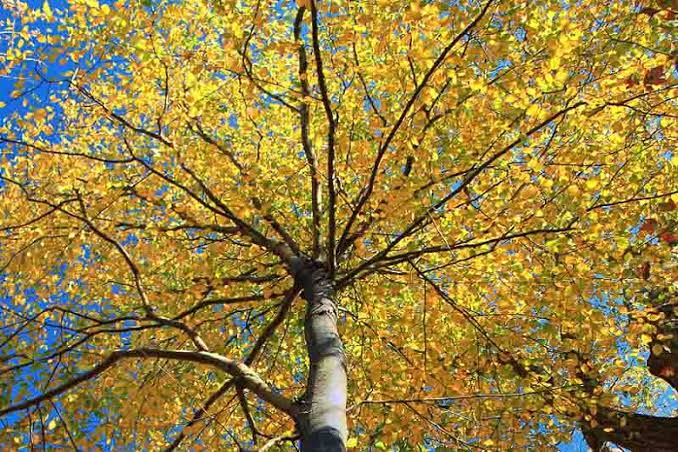
Sweet birch also commonly called cherry birch or black birch, grows to between 30 and 40 feet in height in the landscape. Young trees are pyramidal and dense forming an irregular, rounded, sometimes wide-spreading crown at maturity. Sweet birch lives to a maximum of 200 years. The deciduous leaves are glossy dark green above and paler beneath.The leaves turn bright yellow in autumn before dropping. This variety of birch is considered to have the best fall color of any birch. Similar to cherry trees, the bark on mature sweet birches becomes plated due to vertical cracks forming.
Also Read: Landscaping Trees With White Bark
Ginko biloba

Commonly called maidenhair tree, Ginkgo biloba is a deciduous species of tree grown for its striking, fan-shaped foliage and tall, stately growth habit. Ginkgo is a slow-growing tree that typically reaches heights between 40 and 70 feet, with a spread between 20 to 40 feet. The habit of the tree ranges from pyramidal to rounded or irregular, showcasing 2- to 3-inch, fan-shaped leaves. The leaves are a rich shade of green in spring and summer before turning to brilliant yellow in fall. Female trees produce a notorious fruit that is as messy as it is bad-smelling. The tree that can live up to 1,000 years and grow to 120 feet tall.
Black Tupelo

The black gum, black tupelo or sourgum tree is medium-sized, reaching a height of 30 to 50 feet at maturity, with a spread of 20 to 35 feet. Its overall shape is pyramidal, with a dense branching pattern and dark-green, lustrous leaves. In fall, its leaves become many shades of yellow, orange, red and purple, making a spectacular display. The tree is a fast grower that prefers full sun and is unusually resistant to insect pests. It tolerates all types of soil and does well in most locations, including spots that tend to be unusually moist.
Scarlet Oak

Scarlet oak is a medium-sized tree with a long, straight trunk, an open, narrow crown, and sometimes persistent dead branches on the lower trunk. It can be mistaken for the pin oak, the black oak, or occasionally the red oak. Scarlet oak grows quickly to 70 feet tall and 50 feet wide. It tolerates a variety of conditions and is not picky about soil, though it does have a preference for dry, acidic soils. It can be planted on the edge of a wooded area or in the middle of the yard. The leaves of this tree have sharply pointed, coarsely toothed lobes. The color of the leaves ranges from bright red in early spring to dark shiny green in summer then scarlet in fall.
Also Read: Major Types of Maple Trees
Persian parrotia
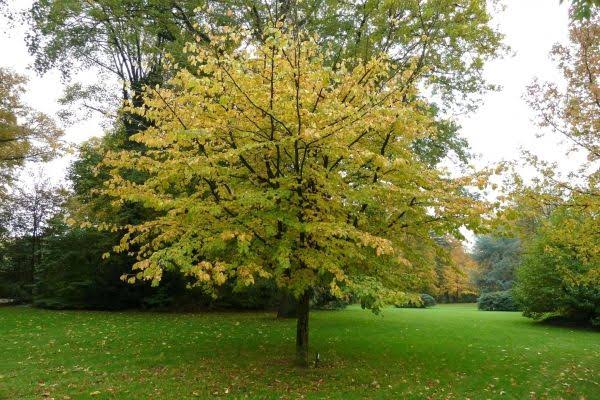
The Persian parrotia tree or Persian ironwood comes from Iran. It is a deciduous tree with low, ascending branches, reaching between 20 and 40 feet in height with about the same spread. It has a slow rate of growth. Its new, alternate leaves first appear in reddish-purple hues in the spring. They eventually turn to dark green in the summer. In the fall, they are red, orange and yellow, suggesting the possibility of an alternate name, the tree of many colors. The Persian parrotia tree features red flowers that bloom between January and March. This tree prefers partial shade to full sun and well-drained soil.
Japanese stewartia

Japanese stewartia is a slow-growing, low-maintenance deciduous tree will eventually grow between 40 and 60 feet tall and spreads 25 feet wide in constantly well-drained moist soil. The plant features white summer flowers with orange centers and dark green leaves that turn reddish-purple in autumn. As its leaved shed, a flaky, multi-colored, and pretty patchwork bark is exposed that gives the tree some winter interest.The bark peels away in strips of gray, reddish-brown, and orange.
Japanese snowbell

The Japanese snowbell tree sometimes called the Japanese snowdrop gets its name from the delicate bell-shaped flowers produced in clusters in springtime. When young, Japanese snowbell trees tend to have a slender shape, but as specimens reach their mature height of 30 feet, they can take on a spread of 30 feet or more. This tree provides the added benefits of an attractive gray-brown bark and colorful fall foliage.The white blossoms are lightly fragrant. Given that the leaves angle upward from the branches and flowers dangle down, the tree takes on the effect of having parallel green and white tiers when in bloom.
Further References
- Flowering Trees: http://americangardener.net/flowering-trees/
- Shrubs with Fall Color: https://www.washingtonpost.com/lifestyle/home/the-15-best-trees-and-shrubs-for-fall-foliage/
- Trees with beautiful fall color: https://www.thespruce.com/most-colorful-trees-for-fall-4020741
- Fall Colored Trees: https://arbordayblog.org/landscapedesign/8-trees-that-flaunt-brilliant-fall-color/
- Trees That Change Color In Fall: https://www.bhg.com/gardening/trees-shrubs-vines/trees/trees-and-shrubs-for-fall/